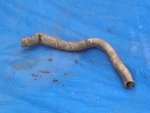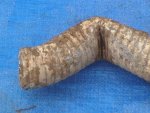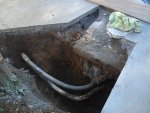Pretty much what the pros said. Chemical damage made it vulnerable to mechanical damage.
Balderdash! :blah:

I'll bet you a lot of money that flex pipe was kinked when it was put in....simply sloppy installation. Why didn't it fail immediately? That kinked part formed a venturi and slowly but surely that venturi applied inward pressure on that pipe and it closed up. Somebody making chemical excuses for poor workmanship in my very humble (but very strong) opinion. :-D :-D
Now, I also have an opinion about pouring bleach in the skimmers. I have been doing it for 6 years without a hitch. My pump runs like it is brand new, my liner has no fading whatsoever and, folks, PVC pipe is one of the most widely used materials where harsh chemicals are involved.
6% chlorine is probably immediately diluted to 1/10th of it's strength before it ever reaches your pump because of the high flow volume. In my case (the skimmer is about 60 feet from the pump), probably even more. Secondly, the chlorine (already heavily diluted) stays inside your pump about 1/2 second I would think....hardly enough time for any chemical reaction to effect the seal. I agree the seal is a vulnerable element but I just cant fathom how it could ever be in contact with strong concentrations of chlorine long enough to have anything but the most marginal, inconsequential effect.
So, am I advocating that each of us go out and dump 15 gallons of 12% directly into the skimmer as fast as they can? Of course not. What I am advocating is that moderation is the keyword that I don't think has been discussed in this thread yet. In other words, If I trickled one cup of bleach every fifteen minutes into the skimmer does anyone realistically think there is harm in that?
I'd be curious to know what kind of piping is used in a chlorine manufacturing facility. I know they put it in plastic jugs when they sell it to you and I know it can sit for years in the plastic jugs with no loss of strength (to the plastic) nor any apparent affect whatsoever.
In my situation, chlorin in the skimmer is noticeably more convenient for me and gives me quicker, more even distribuution throughout the pool. I may have to wear a little egg on my face (it won't be the first time) but I believe chlorine into the skimmer is perfectly harmless if you use some common sense.
PS - regardless of where you choose to put your chlorine, please have your pump running :lol: :lol:





 I'll bet you a lot of money that flex pipe was kinked when it was put in....simply sloppy installation. Why didn't it fail immediately? That kinked part formed a venturi and slowly but surely that venturi applied inward pressure on that pipe and it closed up. Somebody making chemical excuses for poor workmanship in my very humble (but very strong) opinion. :-D :-D
I'll bet you a lot of money that flex pipe was kinked when it was put in....simply sloppy installation. Why didn't it fail immediately? That kinked part formed a venturi and slowly but surely that venturi applied inward pressure on that pipe and it closed up. Somebody making chemical excuses for poor workmanship in my very humble (but very strong) opinion. :-D :-D 